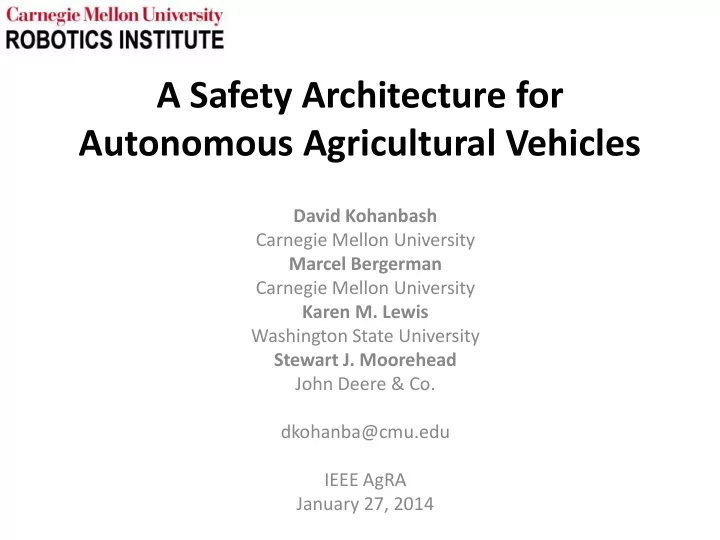

A Safety Architecture for Autonomous Agricultural Vehicles David Kohanbash Carnegie Mellon University Marcel Bergerman Carnegie Mellon University Karen M. Lewis Washington State University Stewart J. Moorehead John Deere & Co. dkohanba@cmu.edu IEEE AgRA January 27, 2014
Why Robots http://www.census.gov/population/international/data/idb/images/worldpop.png
Why Robots Source: Rodney Brooks talk http://www.youtube.com/watch?v=nA-J0510Pxs
Why Robots • Robotics can significantly: – Reduce labor demand – Reduce labor (and other) costs – Increase efficiency Source: Rodney Brooks talk http://www.youtube.com/watch?v=nA-J0510Pxs
Current Robots • Industrial robots have been a crucial part of society for the last 60 years – They operate safely (as long as people are not around), reliably, and do not adept well to change – The user interface does not require intimate knowledge to use the machine – Safety regulations and standards have led safe machine creation
Agricultural Robots • Large • Mowing • Fast • Spraying • Changing Environment • Disease Detection • People • Pest Detection • Easy to reconfigure • Yield Estimation • Pruning • Harvesting • Transporting
Sensing, Computing, & Actuation • Safety Assessments (pre-mortems) • Fail Safely • Appropriate emergency-stops • Autonomy system can not interfere with safety systems • Detect component failures • Avoid damaging people, infrastructure, and crops • Third party verification of safety systems
Human-Machine Interface • Easy to use • Warning lights/sound • Intuitive • Training • Process control (safety vests, signage, etc..)
Standards & Regulations Legal frameworks for testing (and deploying) cars that drive by themselves in Nevada, Florida, California, and the UK.. Google self driving car http://www.geek.com/articles/news/google-wants-self-driving-cars-in-nevada-20110512/google-self-driving-car/ http://www.insideline.com/toyota/prius/blind-man-tests-googles-self-driving-car-on-california-roads.html
-Operator must approve - Operator must approve initial plan -Vehicles should be able to plan and modifications to -Operator should be able to remotely view and communicate paths with each plan modify vehicle plans other when working in close -Must be tested monthly proximity -- 10, 000 testing hours required before vehicle -- Vehicles should notify model can be used unmanned operator when entering a new -- System in place to avoid remote tampering zone including wifi and GPS -- Vehicle must be able to handle being GPS denied -Vehicle should alert driver -Must be able to detect people in various - Vehicles should not maneuver before maneuvering away positions (standing, crouched, laying, operating) around other vehicles without from an obstacle with over 50% person occlusion operator approval -- User should be able to - Stop if obstacle is potentially a person and do take control by grabbing not try to route around steering wheel or pedals -non-autonomous vehicles get right of way -- Must be tested daily -Deadman switch -360degree image view for remote operators - Operator should be able to --Vehicle should stop if - Vehicle should be able to completely stop in x view any remote vehicle perception system seconds of obstacle detection or user command -- Maximum multi-hop degraded -- Real time user communication with less than X communication jump can not - Systems in place to avoid seconds must be maintained exceed X vehicles tampering -- Vehicle should have warning lights and sirens. -- Provide a method to stop all Must begin 1 minute before any motion vehicles. -- Must be tested daily -- Develop system for establishing vehicle keep- out zones
Future Needs • Focus on not just building a system but building a safe system • Attention to user interface • More standards to guide autonomous (or semi-autonomous) vehicles
Thank You Lets start the discussion… This work is partially supported by the US Dept. of Agriculture National Institute for Food and Agriculture under award nos. 2008-51180-04876 and 2008-51180- 04890.The Autonomous Orchard Tractors were funded internally by John Deere.
Recommend
More recommend